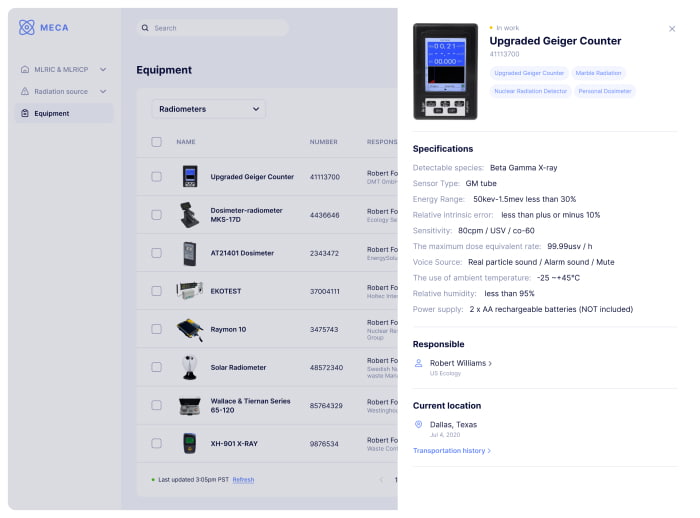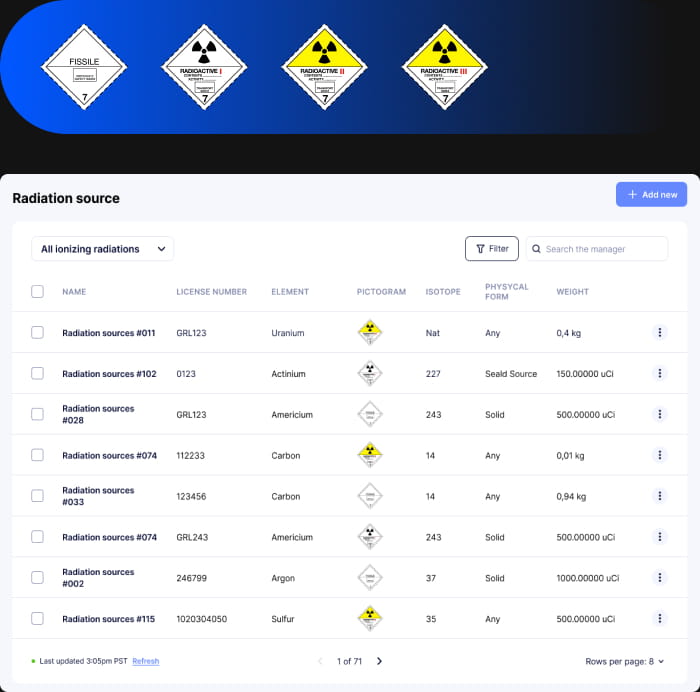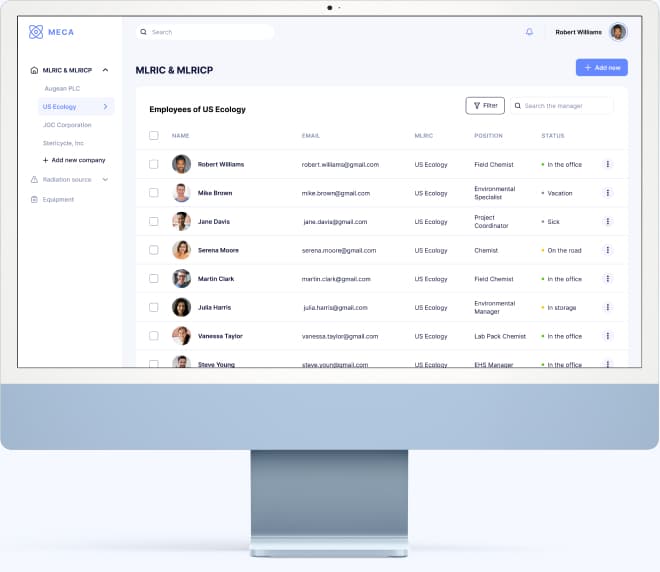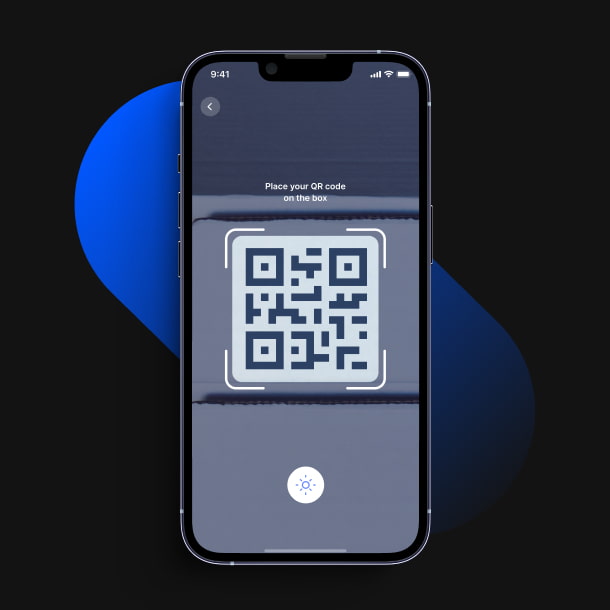Blockchain-Based Radioactive and Hazardous Material Management System
- Home
- Success stories
- Blockchain-Based Radioactive and Hazardous Material Management System
Project goals
Build a blockchain ecosystem with a web and mobile interface that would enable the processes of radioactive materials storage, transport, and disposal to be carried out transparently. The platform needed to provide efficient data management with access roles tied to administrators and storage facility personnel who handle the transport of hazardous materials and associated operations.
Work done
- 1Administrator web portal for enforcing policies and regulations, managing storage, and transporting radioactive materials.
- 2Full integration with existing ERP systems and SAP modules, including warehouse management, trip and delivery, transportation, automation planning, administration, etc.
- 3Mobile application for storage facility personnel to take radioactive materials into custody and manage their proper handling.
Solution
Technologies used:
Typical use cases
Materials management
The platform can be used by hospitals, research facilities, and manufacturing sites to document and track the maintenance of hazardous materials, and monitor equipment and storage facility conditions.Overseeing of materials handling
Using the platform, government authorities and companies that deal with these materials can oversee radioactive material handling. Government authorities can also audit and verify these processes and issue licenses to the organizations.

Radiation management

Equipment management
- Container tracking
- Inventory management
- Treatment and conditioning
- Authorization and approval
- Generating inventory reports
- Storage and disposal
- Waste management

Radiation source tracking
- Shipping and transportation
- Receiving areas
- Warehouses and storage facilities
- Manufacturing and processing lines
- Lobbies and security posts
- Laboratories
- Disposal facilities.
Security management
In order to ensure safe and secure handling, and to avoid the risks of injury and damage to property as a result of mishandling, the system offers convenient digital material safety data sheets (MSDS) management.
- Each data sheet is tied to the specific hazardous material
- The data sheets contain information on material properties, its composition, physical health, environmental hazards, protective measures, and safety precautions for handling and transporting the material
- The data sheets can be accessed from the handler’s mobile device by scanning the QR code of the container, thus enabling the personnel at each location of the supply chain or within a storage facility to know the exact safety procedures
The platform also allows generating compliance reports that can be directly accessed and verified by regulatory authorities.
Security management

Radiation asset management
The solution offers the admin web portal, which is used by the representatives of the regulative authority for creating new records of radiation sources and materials. The system also allows them to specify the material’s parameters and details, such as the radiation level.
- 1
Record creation
A record is created and added to the blockchain and timestamped according to the date of its creation.
- 2
Materials movement tracking
The timestamp can be later used to track the movement of certain materials and view their maintenance history all the way back to their origins.
- 3
QR code assignment
A QR code is also assigned to the new radiation source and used by storage facility personnel for acceptance.
- 4
Records tracking
Organizations view the created records of radioactive materials assigned to them, as well as the history of transfers of these materials from the place they are utilized to the disposal facilities.
Blockchain implementation benefits
Since all the information is recorded on the blockchain and distributed across the whole supply chain landscape, there’s no more trouble with different parts of the system being isolated and no need for complex integrations of distributed databases and legacy applications.

- Using Hyperledger as a platform for hazardous material management brings the following advantages for companies and regulatory authorities:
- Easy access to all the information required for managing hazardous materials, with extensive capabilities for searching and filtering
- Everyone works within a single environment, so regulatory experts are able to directly enforce requirements and companies have an easier way to maintain compliance
- By eliminating redundant processes and streamlining information exchange, the system enables hazardous material storage to be more secure and significantly reduces operational expenses
- Another major benefit of a platform based on blockchain is the use of smart contracts to eliminate third-party certification and verification processes. All of the terms and requirements are programmed into the smart contract, and it automatically executes after its conditions have been met. It results in the following benefits:
- It speeds up compliance and exchange processes considerably
- It also builds more trust, since agreements are executed through an unbiased digital process
Radioactive material handling and disposal with mobile app

QR codes to scan radioactive materials
Storage facility personnel have the ability to scan QR codes of radioactive materials and take them under their custody. They can also view all the materials, record maintenance details and other parameters, and monitor storage conditions.

360-degree view of materials handling
This information is recorded on the blockchain and distributed across all users with the proper access rights. Thus, all of the parties involved have a bird’s-eye view over radioactive material handling and disposal.
Project features
- Hyperledger Fabric blockchain storage to provide universal access for all stakeholders
- Radiation source management
- Radiation equipment management
- Full history of radiation source movements and handling
- QR codes generated to identify radiation materials
Services
We offer a comprehensive range of services, including IT consulting, custom software development, and specialized expertise in blockchain, machine learning, and data science.
Blockchain Development
Blockchain Development
Smart Contract Development
Web3 Development
Crypto Payment Solutions
Tokenization Services
Protocols
Protocols
Cryptocurrency Exchange Development
Cryptocurrency Development
Top Development Company
Blockchain Consulting
Top Blockchain Consulting Company
Custom Software Development
Mobile App Development
Web Development
Top IT Services Company
IT Consulting
Top Consulting Company
ML Development
Artificial Intelligence Development
Machine Learning Development
Data Science Development
Top BI & Big Data Company
AR & VR Development
AR & VR Development
QA & Software TestingQA & Software Testing Services
UI/UX DesignGive us the pleasure of adding our secret sauce to your app.
We’ll create beautiful screens at the front while breaking the limits of what’s behind them to help your app get to beyond-plausible business achievements.
UI/UX Design Services
MVP DevelopmentValidate your product idea quickly with an MVP—launch faster, test smarter, and refine based on real user feedback.
Leverage our expertise in MVP development to build a scalable, market-ready product with minimal risk and maximum efficiency.
MVP Development Services
Metaverse Consulting & DevelopmentValidate your immersive concept quickly with metaverse development — launch your virtual experience, gather actionable user insights on core features like avatars and social interaction, and iterate based on real-world engagement.
Top Development Company
Solutions
RWA PlatformTokenization makes it easier to trade assets and opens up new investment opportunities and diversifies portfolio.
RWA Platform
Asset tokenization platform development
Arbitrage BotProfit from market inefficiencies with automated, customized trading strategies that boost returns and minimize risk.
Arbitrage Bot
Be a transaction ahead. Catch profit at short notice
CryptoAPIGain an unfair data edge for your dApps. Tap into high-quality blockchain insights to outsmart competitors and fuel smarter decisions.
CryptoAPI
Connect your dApps to blockchain networks in a flash
OTC HawkOffer high-net-worth clients a secure, enterprise-grade trading terminal. Streamline deals, enhance reliability, and optimize top-tier crypto assets.
OTC Hawk
Benefit from our portfolio and wealth management app
DocFlowManage sensitive documents on blockchain. Leverage optional zero-knowledge proofs for trust, privacy, and streamlined workflows.
DocFlow
Intuitive Blockchain-Powered Document Management System
Know-Your-TransactionEnsure every transaction is above board. Monitor digital asset flows for compliance and transparency, supporting both businesses and regulators.
KYT crypto platform
Our KYT platform fosters integrity of financial ecosystems
Industries
We work across a variety of industries, from FinTech to eCommerce, leveraging our accumulated knowledge and best practices to deliver solutions tailored to the unique needs of your business.
FinTech & BankingAs traditional finance goes digital, we are committed to building efficient ecosystems and better engagement.
Think of customized FinTech solutions with tamper-proof transactions and storage, progress transparency and automation — and we’ll make them see the light of day.
$25T
Global Financial Services
20%
Digital/Blockchain Growth
Solutions for FinTech & Banking
Retail & eCommerceWhether you market B2B or B2C, commerce tech trends are all about value-driven purposes, global sustainability, hybrid shopping journeys, and extra-resiliency.
Let your clients know that there’s more to your brand than meets the eye by creating unique customer experiences in all your stores.
$6.3T
Global eCommerce
10-15%
Tech Innovation Growth
Solutions for Retail & eCommerce
Supply Chain & LogisticsTo make things easier for all vendors, we deliver apps for route and cost optimization, vehicle operational support, and better dispatch time efficiency.
With focus is sustainability, resilience, transparency, and immutability, let’s get your transformation going.
$10T
Global Logistics
15-20%
Blockchain Adoption Growth
Solutions for Supply Chain & Logistics
HealthcareCustom healthcare software solutions are aimed at helping you ensure accurate diagnosis, better patient engagement, and positive healthcare outcomes.
Whether you require a patient management solution, practice management software, EMR/EHR system, or ML-enabled diagnostics – we’ve got you covered.
$10T
Global Healthcare
20%
Digital/Blockchain Growth
Solutions for Healthcare
Real EstateKeep up with digital innovation trends by accelerating enterprise transformation and scaling, leveraging data and orchestrating workflows.
Whether you manage and sell commercial facilities or invest third-party capital, our integrated solutions help you make the most of it.
$340T
Global Real Estate
15%
PropTech/Blockchain Growth
Solutions for Real Estate
Oil & GasWith mobility and digital technologies standing to change the game and define leadership, our mission is to get you digital-first.
Resolve operational and conceptual issues by introducing clear tech vision, feasible architectures, and flexible software to take business extension off limits.
$4T
Global Oil & Gas Industry
10-15%
Digital/Blockchain Growth
Solutions for Oil & Gas Industry
InsuranceImagine a world where quoting policies, processing claims, and managing mountains of paperwork are effortless. PixelPlex can help you achieve just that.
Break free from outdated systems and focus on what truly matters – delivering exceptional service to your policyholders and growing your insurance business.
$25T
Global financial services
20%
Digital/blockchain growth
Solutions for Insurance Industry
FitnessWe create custom fitness software solutions that support meaningful training and steady engagement from the first session.
If you’re building a digital product for active users and need a team with real project experience behind it, we’ll help you bring it to life with clarity and purpose.
$257B
Global Fitness Industry
24%
Digital Growth
Solutions for Fitness
Success stories
Domain
Industry
Protocols
Company
About us Team Careers Social Responsibility ContactsBlog
Blockchain Big Data Artificial Intelligence AR/VR Mobile News View Blog